Abstract
A severe outbreak of hemorrhagic colitis occurred in London, Ontario, during the month of September 1985. A total of 55 residents and 18 employees of a nursing home developed diarrhea, and 17 residents (age range, 78 to 99 years) died. Specimens from 38 patients, 37 employees and contacts, and 10 autopsies were investigated for all enteric pathogens. Specimens were also planted on MacConkey-sorbitol agar. Fecal extracts were tested on Vero cells for cytotoxin (FVT). Escherichia coli isolates were serotyped and tested for verotoxin and beta-glucuronidase production. Of the 38 symptomatic patients, 26 were positive for FVT, verotoxin-producing E. coli (VTEC), or both. Of the 105 specimens that were examined from these 38 patients, FVT and VTEC were both positive in 30 specimens, FVT only was positive in 13 specimens, and VTEC only was positive in 4 specimens. None of the 27 specimens from 10 autopsies was positive for FVT or VTEC. No other enteric pathogen was found in any of the cases. All asymptomatic individuals were negative for both FVT and VTEC. Of 19 VTEC strains that were isolated, 18 belonged to serotype O157:H7. These 18 strains and 2 more strains that were obtained from sporadic cases that had occurred within the 2 previous months were found to give similar biochemical reactions in a 36-test identification system. All isolates of serotype O157:H7 were beta-glucuronidase negative and susceptible to the antimicrobial agents that are used to treat E. coli infections. Testing for FVT and VTEC was found to be the most sensitive and specific technique for the laboratory diagnosis of this disease. Negative sorbitol, positive raffinose, and negative beta-glucuronidase tests appeared to be consistent markers for aiding in the detection of E. coli O157:H7.
Full text
PDF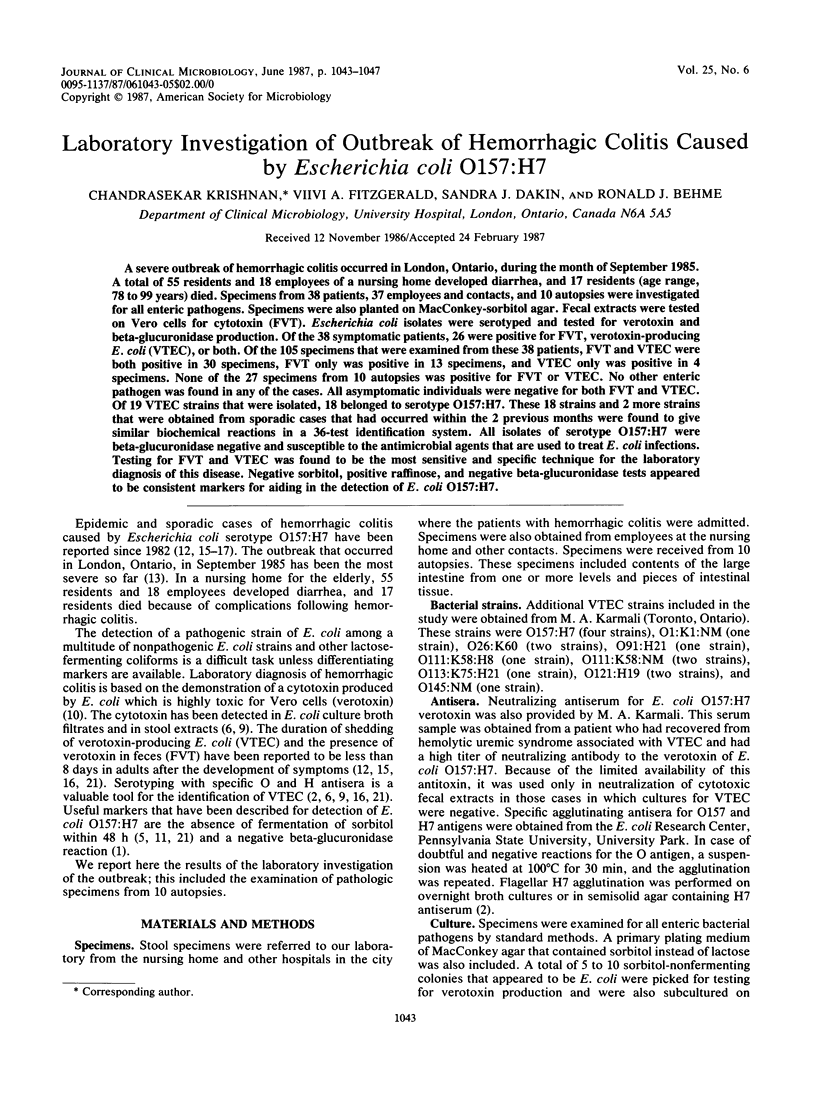
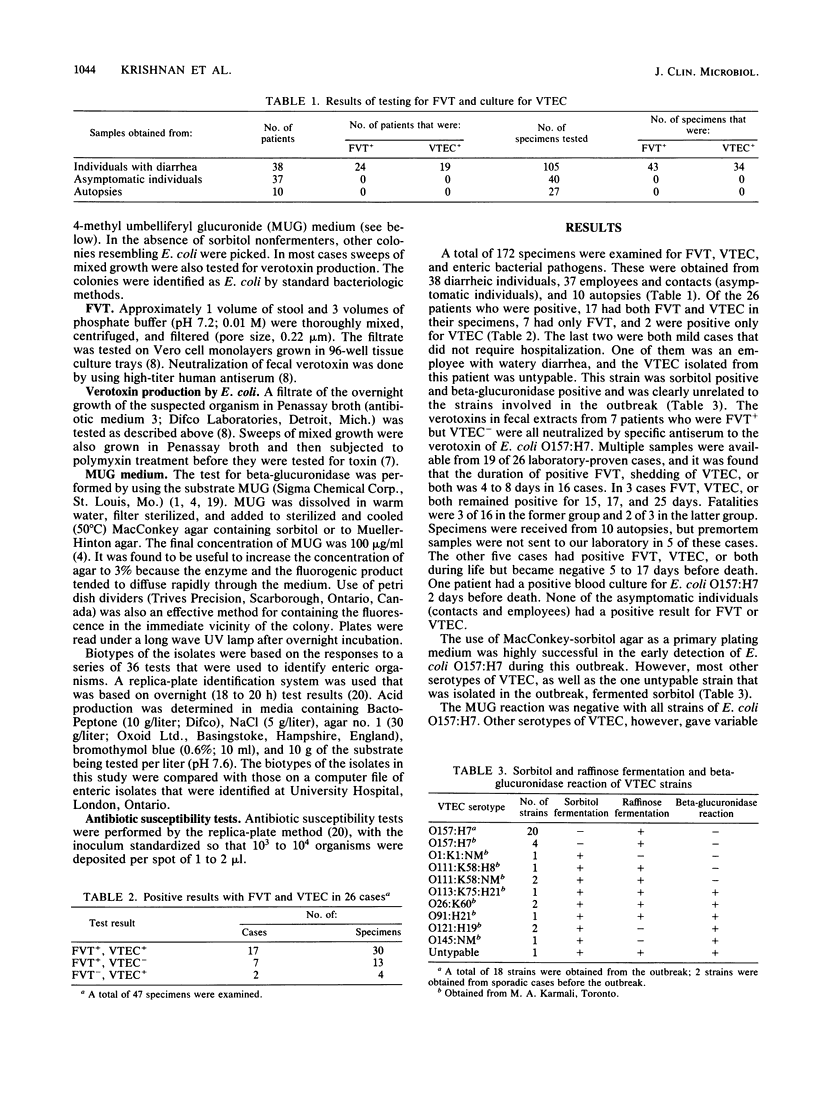
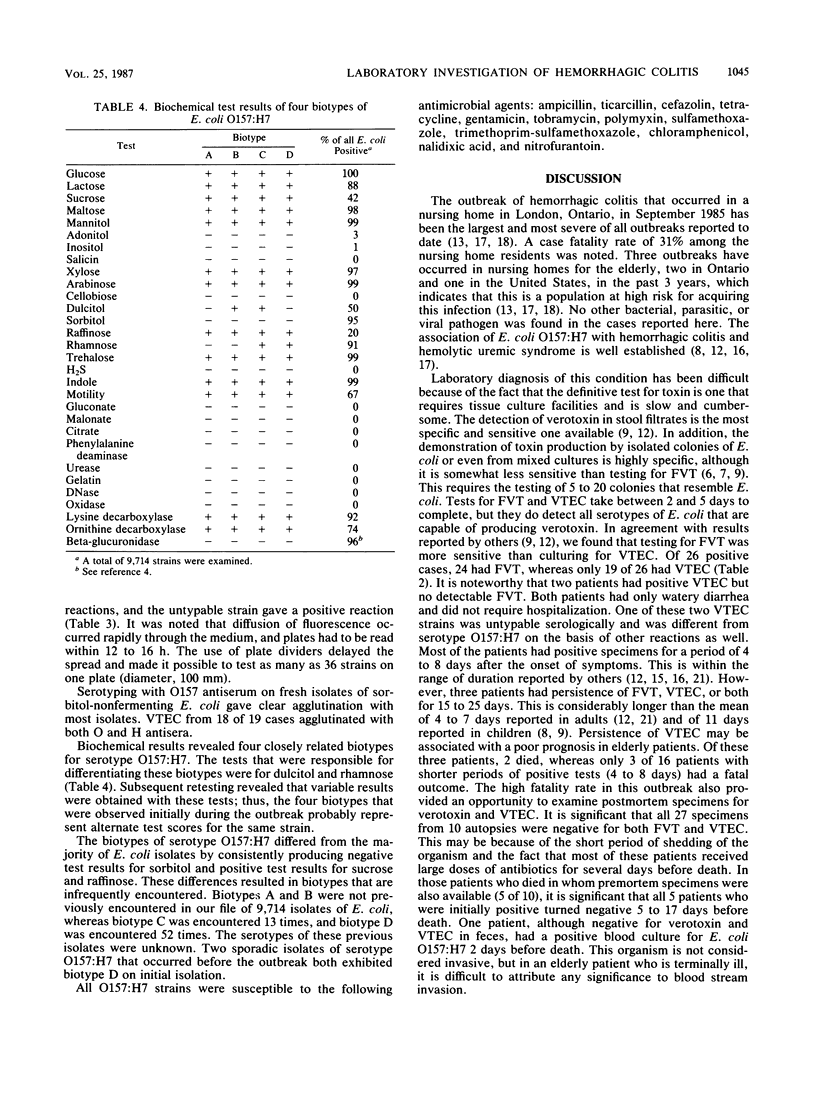
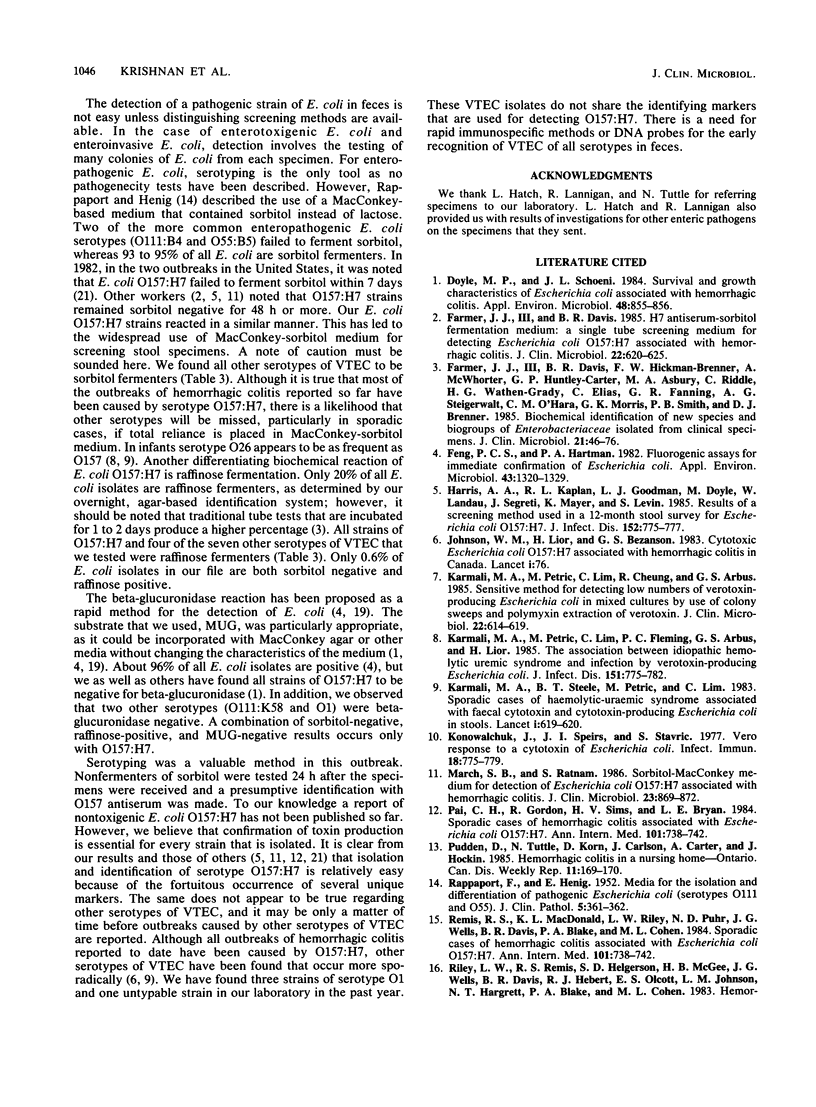
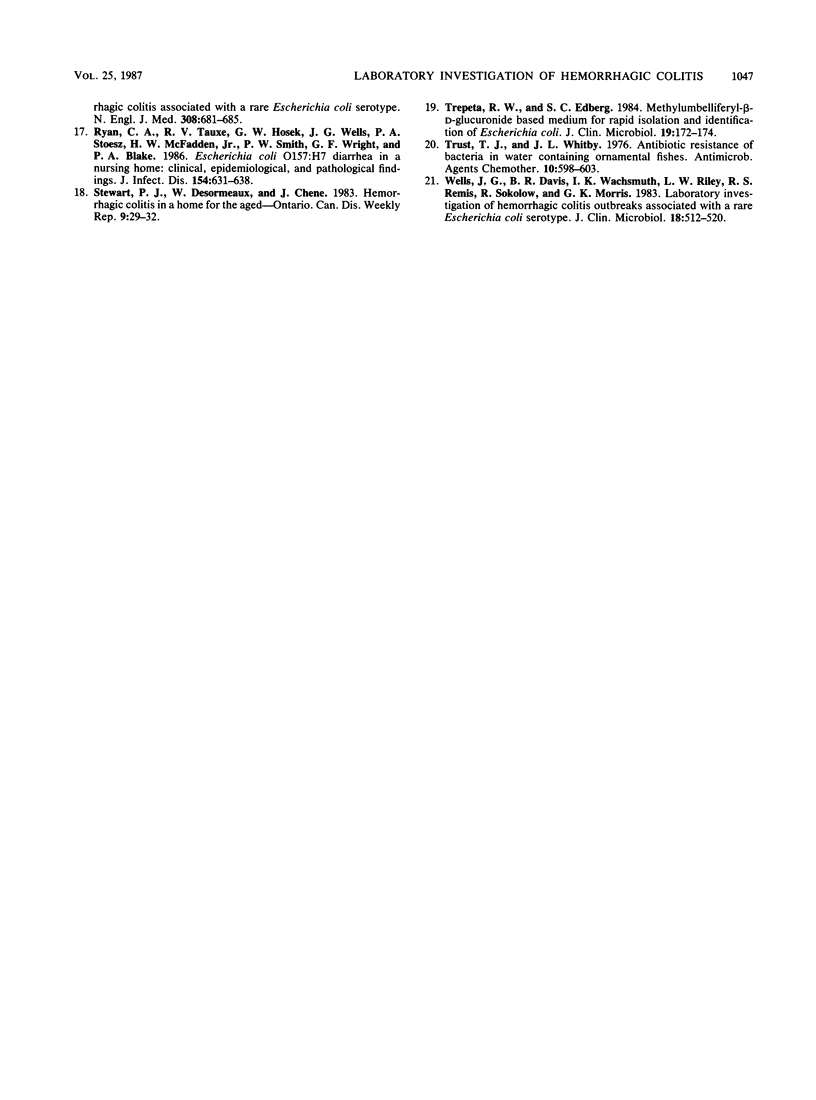
Selected References
These references are in PubMed. This may not be the complete list of references from this article.
- Doyle M. P., Schoeni J. L. Survival and growth characteristics of Escherichia coli associated with hemorrhagic colitis. Appl Environ Microbiol. 1984 Oct;48(4):855–856. doi: 10.1128/aem.48.4.855-856.1984. [DOI] [PMC free article] [PubMed] [Google Scholar]
- Farmer J. J., 3rd, Davis B. R. H7 antiserum-sorbitol fermentation medium: a single tube screening medium for detecting Escherichia coli O157:H7 associated with hemorrhagic colitis. J Clin Microbiol. 1985 Oct;22(4):620–625. doi: 10.1128/jcm.22.4.620-625.1985. [DOI] [PMC free article] [PubMed] [Google Scholar]
- Farmer J. J., 3rd, Davis B. R., Hickman-Brenner F. W., McWhorter A., Huntley-Carter G. P., Asbury M. A., Riddle C., Wathen-Grady H. G., Elias C., Fanning G. R. Biochemical identification of new species and biogroups of Enterobacteriaceae isolated from clinical specimens. J Clin Microbiol. 1985 Jan;21(1):46–76. doi: 10.1128/jcm.21.1.46-76.1985. [DOI] [PMC free article] [PubMed] [Google Scholar]
- Feng P. C., Hartman P. A. Fluorogenic assays for immediate confirmation of Escherichia coli. Appl Environ Microbiol. 1982 Jun;43(6):1320–1329. doi: 10.1128/aem.43.6.1320-1329.1982. [DOI] [PMC free article] [PubMed] [Google Scholar]
- Harris A. A., Kaplan R. L., Goodman L. J., Doyle M., Landau W., Segreti J., Mayer K., Levin S. Results of a screening method used in a 12-month stool survey for Escherichia coli O157:H7. J Infect Dis. 1985 Oct;152(4):775–777. doi: 10.1093/infdis/152.4.775. [DOI] [PubMed] [Google Scholar]
- Johnson W. M., Lior H., Bezanson G. S. Cytotoxic Escherichia coli O157:H7 associated with haemorrhagic colitis in Canada. Lancet. 1983 Jan 1;1(8314-5):76–76. doi: 10.1016/s0140-6736(83)91616-1. [DOI] [PubMed] [Google Scholar]
- Karmali M. A., Petric M., Lim C., Cheung R., Arbus G. S. Sensitive method for detecting low numbers of verotoxin-producing Escherichia coli in mixed cultures by use of colony sweeps and polymyxin extraction of verotoxin. J Clin Microbiol. 1985 Oct;22(4):614–619. doi: 10.1128/jcm.22.4.614-619.1985. [DOI] [PMC free article] [PubMed] [Google Scholar]
- Karmali M. A., Petric M., Lim C., Fleming P. C., Arbus G. S., Lior H. The association between idiopathic hemolytic uremic syndrome and infection by verotoxin-producing Escherichia coli. J Infect Dis. 1985 May;151(5):775–782. doi: 10.1093/infdis/151.5.775. [DOI] [PubMed] [Google Scholar]
- Karmali M. A., Steele B. T., Petric M., Lim C. Sporadic cases of haemolytic-uraemic syndrome associated with faecal cytotoxin and cytotoxin-producing Escherichia coli in stools. Lancet. 1983 Mar 19;1(8325):619–620. doi: 10.1016/s0140-6736(83)91795-6. [DOI] [PubMed] [Google Scholar]
- Konowalchuk J., Speirs J. I., Stavric S. Vero response to a cytotoxin of Escherichia coli. Infect Immun. 1977 Dec;18(3):775–779. doi: 10.1128/iai.18.3.775-779.1977. [DOI] [PMC free article] [PubMed] [Google Scholar]
- March S. B., Ratnam S. Sorbitol-MacConkey medium for detection of Escherichia coli O157:H7 associated with hemorrhagic colitis. J Clin Microbiol. 1986 May;23(5):869–872. doi: 10.1128/jcm.23.5.869-872.1986. [DOI] [PMC free article] [PubMed] [Google Scholar]
- Pai C. H., Gordon R., Sims H. V., Bryan L. E. Sporadic cases of hemorrhagic colitis associated with Escherichia coli O157:H7. Clinical, epidemiologic, and bacteriologic features. Ann Intern Med. 1984 Dec;101(6):738–742. doi: 10.7326/0003-4819-101-6-738. [DOI] [PubMed] [Google Scholar]
- Pai C. H., Gordon R., Sims H. V., Bryan L. E. Sporadic cases of hemorrhagic colitis associated with Escherichia coli O157:H7. Clinical, epidemiologic, and bacteriologic features. Ann Intern Med. 1984 Dec;101(6):738–742. doi: 10.7326/0003-4819-101-6-738. [DOI] [PubMed] [Google Scholar]
- RAPPAPORT F., HENIG E. Media for the isolation and differentiation of pathogenic Esch. coli (serotypes O 111 and O 55). J Clin Pathol. 1952 Nov;5(4):361–362. doi: 10.1136/jcp.5.4.361. [DOI] [PMC free article] [PubMed] [Google Scholar]
- Riley L. W., Remis R. S., Helgerson S. D., McGee H. B., Wells J. G., Davis B. R., Hebert R. J., Olcott E. S., Johnson L. M., Hargrett N. T. Hemorrhagic colitis associated with a rare Escherichia coli serotype. N Engl J Med. 1983 Mar 24;308(12):681–685. doi: 10.1056/NEJM198303243081203. [DOI] [PubMed] [Google Scholar]
- Ryan C. A., Tauxe R. V., Hosek G. W., Wells J. G., Stoesz P. A., McFadden H. W., Jr, Smith P. W., Wright G. F., Blake P. A. Escherichia coli O157:H7 diarrhea in a nursing home: clinical, epidemiological, and pathological findings. J Infect Dis. 1986 Oct;154(4):631–638. doi: 10.1093/infdis/154.4.631. [DOI] [PubMed] [Google Scholar]
- Trepeta R. W., Edberg S. C. Methylumbelliferyl-beta-D-glucuronide-based medium for rapid isolation and identification of Escherichia coli. J Clin Microbiol. 1984 Feb;19(2):172–174. doi: 10.1128/jcm.19.2.172-174.1984. [DOI] [PMC free article] [PubMed] [Google Scholar]
- Trust T. J., Whitby J. L. Antibiotic resistance of bacteria in water containing ornamental fishes. Antimicrob Agents Chemother. 1976 Oct;10(4):598–603. doi: 10.1128/aac.10.4.598. [DOI] [PMC free article] [PubMed] [Google Scholar]
- Wells J. G., Davis B. R., Wachsmuth I. K., Riley L. W., Remis R. S., Sokolow R., Morris G. K. Laboratory investigation of hemorrhagic colitis outbreaks associated with a rare Escherichia coli serotype. J Clin Microbiol. 1983 Sep;18(3):512–520. doi: 10.1128/jcm.18.3.512-520.1983. [DOI] [PMC free article] [PubMed] [Google Scholar]


